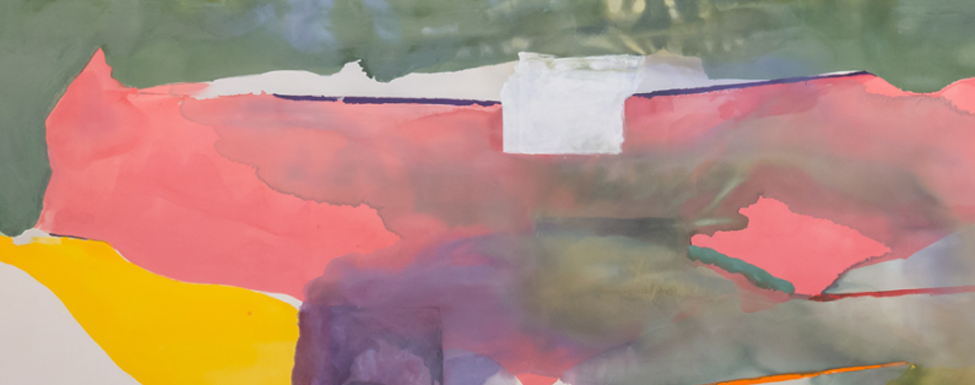Frankenthaler at the Clark
The constraints of the post-Victorian world were well and truly broken following two world wars and a Great Depression. Earlier Victorian realism no longer seemed relevant after decades of disruption.
The abrupt disjunctures of Cubism were seen as fitting expressions of society’s fractures and were explored by artists such as Picasso, whose works are currently on view in an exhibition at The Clark in Williamstown MA.
The Clark is taking a simultaneous look at a further evolution of 20th-century art in the works of Helen Frankenthaler, whose works are being shown in two companion exhibitions, As in Nature: Helen Frankenthaler Paintings (July 1st–October 9th) and No Rules (July 1st–Sept. 24th). As in Nature focuses on nature as a long-standing inspiration for the artist and is presented in the Lunder Center at Stone Hill while No Rules explores her revolutionary work in woodblock prints.
The Clark is renewing its association with the artist with these exhibitions. Frankenthaler, a graduate of Bennington College, maintained a lifelong connection with that institution and established numerous connections to the region. During the 1979–80 academic year, Frankenthaler was part of the Williams College Artist-in-Residence Program and, at the culmination of her tenure, the Clark presented a comprehensive exhibition of her prints.
Frankenthaler was the daughter of Alfred Frankenthaler, a New York State Supreme Court judge, and Martha Lowenstein, whose family emigrated from Germany to the United States. Growing up on Manhattan's Upper East Side, Frankenthaler absorbed the privileged background of a cultured and progressive Jewish intellectual family. While at Bennington College, Frankenthaler studied under Paul Feeley, who is credited with helping her understand composition, as well as influencing her early cubist-derived style.
Frankenthaler, who went on to become one of the most influential artists of the mid-20th century, was introduced early in her career to major artists such as Jackson Pollock, Franz Kline and Robert Motherwell, who became her first husband.
She fell under the spell of Abstract Expressionism, but did not stop there. She soon developed her own "soak-stain" method, a variation on Jackson Pollock’s pouring technique that became the foundation for the Color Field school of painting. Her paints were thinned with turpentine and soaked into the raw canvas, producing luminous, misty color washes.
In 1952, she created her seminal work, using her soak-stain method in “Mountains and Sea,” produced upon her return from a trip to Nova Scotia. While she once described the painting as “looking to many people like a large paint rag, casually accidental and incomplete,” critics laud its “delicate balance of drawing and painting, fresh washes of color and breakthrough technique.”
Most importantly, it satisfied the artist. “The landscapes were in my arms as I did it,” Frankenthaler told an interviewer. “I didn’t realize all that I was doing. I was trying to get at something—I didn’t know what until it was manifest.”
Subsequently, she sought to replicate the method's effects in printmaking, creating woodcuts that not only resembled paintings, but also achieved the watercolor-like quality of her color washes.
The Clark has included twelve of the artist’s large-scale paintings in As in Nature.They span the full range of styles, techniques and formal preoccupations that Frankenthaler explored over five decades. The paintings are primarily abstract, yet reveal recognizable elements from landscapes.
Frankenthaler, who died in 2011, had a long-standing, if ambivalent, relationship to the tradition of landscape painting. She continually tested the limits of the genre, at times inserting elements of representation into her work, which made the abstract elements all the more pronounced.
In the second Frankenthaler exhibition, No Rules—the exhibition’s name derives from Frankenthaler’s comment, “There are no rules. Let the picture lead you where it must go”—The Clark explores her groundbreaking approach to the woodcut. Throughout her career, Frankenthaler collaborated with a variety of print publishers to push the medium in new directions. In 1983, she worked with the expert woodcarver Reizo Monjyu in Japan and the printer, Tadashi Toda. These efforts resulted in an entirely new, layered approach to color that differed from traditional forms of woodcut.
In the 1990s and early 2000s, Frankenthaler continued to experiment in woodcuts such as Freefall, working with dyed paper pulp printed with color blocks to create layers of color. For Tales of Genji (1998) and Madame Butterfly (2000), she again collaborated with an expert Japanese carver, printers and papermakers to produce a series of prints that are landmarks in the evolution of the woodcut medium.
Painting was not the only art form in transition in the post-war world. Contemporaneous, an ensemble of twenty-one musicians, will showcase the musical landscape of the Frankenthaler era on August 19th at 4PM in the Lunder Center. The concert will include works by Frederick Rzewski, Philip Glass and Pauline Oliveros.
This program offers a snapshot of the experimental music scene in New York from the late 1950s through the early 1970s. In each of these three pieces lies a revolutionary directness and a baring of the creative impulse—a similar approach taken by Frankenthaler, according to The Clark.
Preceding the concert, musicians will lead Oliveros’ “Heart Chant,” an audience-participation ritual to be held outdoors at 3:15PM at Thomas Schütte: Crystal. Participants then walk the trail to the Lunder Center at Stone Hill for the main concert.
The Clark is grateful to the William Louis-Dreyfus Foundation and the Helen Frankenthaler Foundation for their loans of Frankenthaler’s art.
The Clark is located at 225 South Street, Williamstown MA. For more information call 413-458-2303 or click on the link below.

